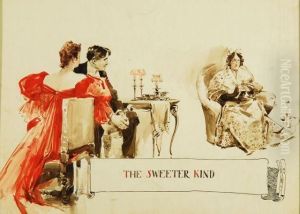Charles Howard Johnson Paintings
Charles Howard Johnson was an American illustrator known for his work in popular magazines during the golden age of American illustration, at the turn of the 20th century. Born on February 15, 1864, in New York City, Johnson's talent became evident at a young age, and he pursued an education in the arts to hone his skills.
Johnson attended the prestigious National Academy of Design in New York and later continued his studies at the Académie Julian in Paris, where he was exposed to the rich artistic culture of Europe and the influences of the Belle Époque. His time in Paris had a considerable impact on his artistic development, and he absorbed the techniques and styles that would later characterize his work.
Upon his return to the United States, Johnson began his career as an illustrator, a profession that was growing in prestige and demand thanks to the proliferation of magazines and newspapers. He quickly became a sought-after artist, contributing to publications such as 'Harper's Weekly,' 'Life,' and 'Puck.' His work often included humorous and satirical illustrations, and he was known for his ability to capture the zeitgeist of American life through his art.
Johnson's illustrations reflected the social and cultural changes of the period, particularly the evolving roles of women and the shifting norms of the Victorian era to the more progressive attitudes of the early 20th century. He possessed a keen eye for detail and a deft hand at caricature, which made his illustrations resonate with both the public and his peers.
Throughout his career, Johnson also contributed to advertising and produced a number of posters, which were becoming a popular form of mass communication. His style was versatile, allowing him to move between serious and comedic tones with ease, a testament to his skill as an artist.
Charles Howard Johnson's legacy is that of an illustrator who captured the spirit of his time with wit and artistry. He passed away on January 3, 1931, leaving behind a body of work that continues to be appreciated for its historical value and artistic merit. Johnson's illustrations remain a vibrant part of the history of American art, reflecting the dynamic and changing society of the late 19th and early 20th centuries.
